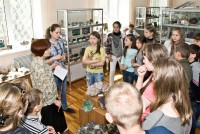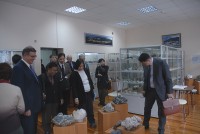The Geology-Mineralogical Museum of the Far Eastern Geological Institute FEB RAS
 |
 |
The Geology-Mineralogical Museum of the Far Eastern Geological Institute FEB RAS, founded in 1978, ranks second to none in the region due to its wealth and presentability of collections. More than 8 thousand samples, that show the variety of rocks, minerals and ores of the continental part of the Russian Far East and the bottom of the Pacific Ocean, are stored here. The most part of them includes the archival materials that are used by geologists, mineralogist, petrographers and paleontologists for scientific purposes. The items of the museum are sorted into 6sections: mineralogy, petrography, mineral deposits, paleontology, lithology, author’s thematic and monographic collections. Regularly renovating exhibition area, consisting of about 1500 rare and unique historical monuments made of stone, allows us to discover, deeply and extensively, the geology of the region, the evolution of its organic life, to see integrity, harmony and variety of natural processes and imagine thematically the fast-paced planet.
For instance, in the showcases there are a lot of deposits of Prymorye that are often called the Second Urals. There is the concentric zonal, eutaxitic, radial fibrous datolite-hedenbergite-wollastonite Dal’negorsk skarn of the borosilicate deposit – “PrymoryeGreen Copper (Malachite)”; due to its variety of structure patterns, beautiful colour and rigidity it is very popular and used in applied stonecutting sphere. Vosnesensk fluorspar deposit is presented in the collection with the samples of ores of massive or augen texture and including mineralization of rocks.
The samples from gold ore and plumbic zinc deposits, wolframium and tinned deposits of different genetic types of the Russian Far East, apatite-titanic iron ore-titanium magnetite occurrences of Dzhugdzhur, Khalar and Sekhtag anorthositic massifs, and platiniferous Kondyor massif illustrate variety of ores, minerals and nature of mineralization.
The true decorations of the museum are “stone flowers” of Dalnegorsk deposits in Prymorye such as unique in its beauty “calcite roses”, quartz druses, druses of apophyllite, datolite, galena, spalerite and other minerals.
The museum is a large scientific educational center in the Russian Far East. Popularization of research works made by employees of the museum and the institute has become an important part of educational activityby means of author’s displays. The concept of accessibility that was in the basis of the displayshas provided an opportunity to develop thematic excursions for children of different agesincluding preschoolers. The set of lectures about consistence, structure and evolution of Earth in geological time and space, about geological past and mineral deposits of Prymorye, about geoecological problems has been enlarged lately with lectures in gemology, such as “Open slightly the Malachite Box”, “Many-Faced Quartz”, “Brothers of Corundum”, “Mystery of Minerology”, “The Sun in your Palm (about Amber)”, “Stone Legends – Myth and Reality”.
A virtual component and usage of different levels of information contribute to better exposing of the museum exposition. Our film collection (documental films about geological subject) consists of more than 20 scientific documentaries such as “Inside Planet Earth” (Discovery Chanel), “The History of Earth” (BBC), “The Evolution of Life” (BBC), “Walking with Monsters” (BBC), “A Walking with Dinosaurs. Trilogy” (BBC), “Earth: The Power of the Planet” (BBC), “Inside the Volcano” (History Chanel) and others. Due to materials got by scientists of FEGI during detailed geological survey of unique natural places of Primorskiy Krai we have the exposition and the slideshow named “Dying out Volcanoes on the Island Krabbe” and the video called “Ash Rocks in CainozoicCavities in the South-East Prymorye as the Bystanders of Catastrophic Volcanic Eruptions” (virtual geological excursion). Documentary showing in the museum makes it possibleon a real time basisto give knowledge of the planet we live on and of those processes that created its contemporary shape. The museum is currently visited by school and university students and everybody who is interested in beauty and culture of stone. Annually about thousands of people (including guests from Japan, China, Korea, the USA, Sweden, Ireland, Germany and other countries) get to know to exhibitions of this famous culturally educational institution in Vladivostok. For people captured by the world of stone the museum has always been and remains the place of meeting amazing and glorious creations of nature.


